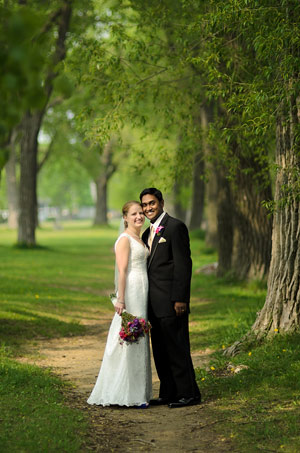
There’s so many different wedding photography pricing models that sometimes it’s hard to know what will be most profitable for you and your business.
Should you have packages? Or go completely A la Carte? Which one books you more clients and gets you higher sales?
There’s an easy way to tell, and the answer will be different for each person.
So first we’ll look at 3 wedding pricing and packaging models, discuss their strengths and weaknesses, and then you’ll learn how to determine which one you should use to maximize your profits.
The Package Model (Most Common)
The most popular wedding photography pricing strategy is to offer a number of different packages to your clients with an A la Carte list of items that they can use to add on to packages.
Let’s be real. For most people who offer packages with an A la Carte list on the side, the A la Carte list is really just there to make the packages look like a better value and photographers don’t really expect people to buy much off of them at all. Yeah, I said it.
While some things are purchased from it, it’s not something they really expect to sell from often. So we’re going to ignore its presence when discussing packages.

Benefits of having pre-defined packages:
You can create your packages in such a way that people generally select the package you want them to select. Yes, really. See Tofurious’ Creative Pricing and Packaging ebook (affiliate link) to learn how. Once I used their methods, about 80% of my clients chose the package I wanted them to with most of the rest choosing a larger package (even better!)
There’s also less decision fatigue. According to the linked article, we’re more apt to stop making good decisions after we’ve made many in a day. Putting together packages of your most commonly purchased items means fewer decisions for people who don’t want to make them.
Downfalls of having pre-defined packages:
People ask to swap things out and change them at A la Carte prices, but they are often discounted because they are sold in a package. This obviously doesn’t apply if you don’t discount from your A la Carte items list.
It also seems like people don’t customize as much because the A la Carte list is seen as extra money on top of what is already in the package or can be viewed as unnecessary extras.

Tips when offering packages:
I’ve been using the package model since the beginning and have found that the most important element to consider in creating your packages is to offer things that people really want in them.
If it’s not something they really want, they will ask to substitute it or take it out causing extra headaches for you.
Provide a great reason for people to upgrade. For example, if the package above the one they’re considering seems to be worth $1000 more but is only $500 more in price, it will seem more valuable to them and encourage them to upgrade.
Buy and read Tofurious’ Creative Pricing and Packaging. I can’t recommend it enough. Sorry for sounding like a broken record, but it truly is amazing and will give far more tips than I can in one little blog post.
A la Carte Only Model
With A la Carte only pricing, you start with an hourly rate and people can hire you for exactly what they need. I know many photographers who use this model successfully as well.

Benefits of A la Carte Pricing:
When you do everything A la Carte, your clients feel like they have a custom package and there’s generally a positive connotation associated with custom purchases.
People get exactly what they want and don’t feel like they are wasting money on something they don’t need. Always a good thing.
Downfalls of A la Carte Pricing:
If you aren’t careful, an A la Carte pricing list may have too many decisions for your clients to make and they may experience decision fatigue, resulting in minimal sales.
It’s easier for people to itemize your services and put a price on every little thing instead of valuing your services as an experience.
I honestly don’t think that sales end up being as high as there’s only one anchor point (initial price points that people see and judge value on), so people won’t vary as far from it as they would if there were several like with packages.
Tips for doing A la Carte Pricing:
Make sure you don’t have too many items on your list. The simpler the list is, the better. Only show what you really want to sell, and leave the rest as “request only” items.
Price your hourly rate high enough that you will be just fine if no one adds a single extra thing onto it. There’s nothing wrong with requiring that at least a certain amount of hours be purchased as well. This avoids people who only want 2 hours on the day of their wedding from taking up an entire day when you could have otherwise been shooting a full wedding.
Walk through the options with them and make it as clear as possible. Have samples of everything you want to sell so that they can hold it and fall in love with it. We value things we can feel more highly than just images of products.
The Guided Choices Model (Hybrid)
My friend Andy has convinced me to change up the way we do pricing by creating a hybrid between offering packages and straight-up A la Carte pricing.
This guides your client through the different things they need to decide by category so it seems like fewer choices to people.
It’s essentially a packaged A la Carte list with instructions.
For example, group your A la Carte items into the following groups, and tell them what choice to make next:

This makes it seem only like 3 decisions instead of deciding if they want each item on your list individually. I’d also add prices next to each item, and then add them up as you go across.
You may also want to add incentives to it, such as a certain number of included goodies with different albums or coverages.
The more I think about this option, the more I think this is genius and is something that I’ll shift to permanently. Here’s why.
It allows for customization but people aren’t overwhelmed by all the options at once. They are split into categories so it makes deciding less stressful.
You can use what you learn about creating packages in how you create the list of options below, so you still get to use the psychology behind pricing packages in it. Pretty cool.
It also clearly tells people what they need to consider. Because the steps are clearly outlined, people will automatically be considering your goodies because it clearly tells them to do that next. Setting expectations of what someone is supposed to do is a really easy way to make them actually do it.
But before I move to using this completely, I need to take my advice below to make sure it does what I think it will.
But how do I know which wedding photography pricing model will be most profitable for me?
 Finally a simple answer, my friends.
Finally a simple answer, my friends.
Split-test it.
Sound scary? It’s not. It’s super easy.
Just create 3 different pricing guides. One with packages, one just as A la Carte, and one Guided Choices guide.
Then send out a different guide every time you get an inquiry. So every 3rd couple will get a the same guide.
Make sure the prices all add up to the same thing on each of them so that you aren’t charging more to some couples than others. This also lets you test which method is most popular and which causes your customers to book more as you know it’s not due to a price change.
It may take some time to determine, but it’s a great way to figure out what really works for you and your customers without just making assumptions based on what you think.
Speak your mind
How do you present your wedding services to your clients? What do you like about it, and what would you like to change? Leave a comment below or on over at our Facebook community!

